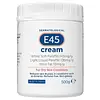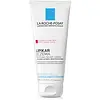What's inside
What's inside
 Key Ingredients
Key Ingredients

No key ingredients
 Benefits
Benefits

No benefits
 Concerns
Concerns

 Ingredients Side-by-side
Ingredients Side-by-side

Colloidal Oatmeal 1%
AbsorbentWater
Skin ConditioningButyrospermum Parkii Butter
Skin ConditioningGlycerin
HumectantDimethicone
EmollientParaffinum Liquidum
EmollientNiacinamide
SmoothingCetearyl Alcohol
EmollientBrassica Napus Seed Oil
EmollientAmmonium Polyacryloyldimethyl Taurate
Emulsion StabilisingPEG-100 Stearate
Glyceryl Stearate
EmollientTocopherol
AntioxidantSodium Benzoate
MaskingPEG-20 Methyl Glucose Sesquistearate
EmulsifyingDimethiconol
EmollientMannose
HumectantXanthan Gum
EmulsifyingPentaerythrityl Tetra-Di-T-Butyl Hydroxyhydrocinnamate
AntioxidantCapryloyl Glycine
CleansingMicrocrystalline Wax
Emulsion StabilisingSorbitan Tristearate
EmulsifyingParaffin
PerfumingDisodium EDTA
Vitreoscilla Ferment
Skin ConditioningCitric Acid
BufferingColloidal Oatmeal 1%, Water, Butyrospermum Parkii Butter, Glycerin, Dimethicone, Paraffinum Liquidum, Niacinamide, Cetearyl Alcohol, Brassica Napus Seed Oil, Ammonium Polyacryloyldimethyl Taurate, PEG-100 Stearate, Glyceryl Stearate, Tocopherol, Sodium Benzoate, PEG-20 Methyl Glucose Sesquistearate, Dimethiconol, Mannose, Xanthan Gum, Pentaerythrityl Tetra-Di-T-Butyl Hydroxyhydrocinnamate, Capryloyl Glycine, Microcrystalline Wax, Sorbitan Tristearate, Paraffin, Disodium EDTA, Vitreoscilla Ferment, Citric Acid
Ingredients Explained
These ingredients are found in both products.
Ingredients higher up in an ingredient list are typically present in a larger amount.
Citric Acid is an alpha hydroxy acid (AHA) naturally found in citrus fruits like oranges, lemons, and limes.
Like other AHAs, citric acid can exfoliate skin by breaking down the bonds that hold dead skin cells together. This helps reveal smoother and brighter skin underneath.
However, this exfoliating effect only happens at high concentrations (20%) which can be hard to find in cosmetic products.
Due to this, citric acid is usually included in small amounts as a pH adjuster. This helps keep products slightly more acidic and compatible with skin's natural pH.
In skincare formulas, citric acid can:
While it can provide some skin benefits, research shows lactic acid and glycolic acid are generally more effective and less irritating exfoliants.
Most citric acid used in skincare today is made by fermenting sugars (usually from molasses). This synthetic version is identical to the natural citrus form but easier to stabilize and use in formulations.
Read more about some other popular AHA's here:
Learn more about Citric AcidGlyceryl Stearate is a mix of glycerin and stearic acid.
It is used to stabilize the mixing of water and oil ingredients. By preventing these ingredients from separating, it can help elongate shelf life. It can also help thicken the product's texture.
As an emollient, it helps soften skin and supports barrier-replenishing ingredients.
In cosmetics, Glyceryl Stearate is often made from vegetable oils or synthetically produced.
This ingredient may not be fungal-acne safe
Fun fact: The human body also creates Glyceryl Stearate naturally.
Learn more about Glyceryl StearateParaffin is a solid created from petroleum. The term 'paraffin' can also refer to either
petroleum jelly or mineral oil.
It has natural occlusive properties which can worsen oily skin. Due to its petrolatum base, this ingredient is not fungal-acne safe.
Paraffinum Liquidum is also known as liquid paraffin. It is a type of highly refined mineral oil.
Like other oils, Paraffinum Liquidum has emollient properties. Emollients help soothe and soften the skin. By creating a barrier to trap moisture within, emollients help keep your skin hydrated.
Paraffinum Liquidum does not irritate the skin and is non-comedogenic.
Learn more about Paraffinum LiquidumWater. It's the most common cosmetic ingredient of all. You'll usually see it at the top of ingredient lists, meaning that it makes up the largest part of the product.
So why is it so popular? Water most often acts as a solvent - this means that it helps dissolve other ingredients into the formulation.
You'll also recognize water as that liquid we all need to stay alive. If you see this, drink a glass of water. Stay hydrated!
Learn more about Water